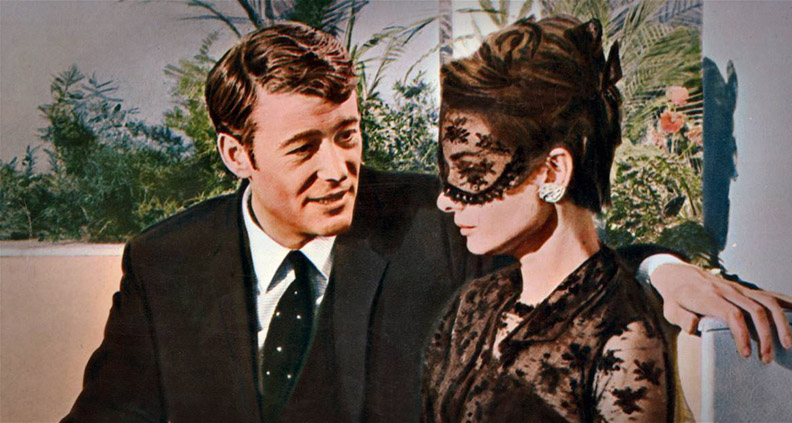Old v. New: Forging Relationships in ‘How to Steal a Million’ and ‘The Art of the Steal’
Each month in Old v. New, Kimberly Marcela Duron compares a newer independent release with an older classic to see what similarities they share, how they diverge, and hear what the conversation between the two films says about the art of filmmaking as it continues to innovate and evolve.
***
When I was in third grade, my art teacher gave us an assignment in which we were to recreate a Monet painting. I chose Water Lilies and Japanese Bridge (1899), carefully matching the strokes of each lily and pad. Not to brag, but my teacher was so impressed she submitted the piece to our local county fair exhibit, for which I won 3rd place. While my career in painting ended there, this was probably the experience that inspired my enduring affection for comedic heist movies set in the art world—particularly ones in which forgery is involved.
One classic example of this subgenre is the 1966 William Wyler-directed comedy, How to Steal a Million. The lighthearted story takes place in Paris—the supposed “art capital of the world”—and tells the tale of an art forger’s daughter, played by Audrey Hepburn, who tries to save her father from being discovered with the help of supposed art thief Simon Dermott, played by Peter O’Toole.
A more contemporary take on this type of heist comedy is the 2013 Canadian film The Art of the Steal, directed by Jonathan Sobol and featuring an ensemble cast led by Kurt Russell and Matt Dillon. In the film, half-brothers Crunch and Nicky Calhoun (Russell and Dillion, respectively) attempt to put their rocky relationship behind them and work together to execute the robbery of a priceless historical book by creating a forged version.
Looking at both films, it’s interesting to see how two seemingly opposite stylistic approaches can be applied to the same general type of film; the two movies’ formal aesthetics are just as different as their central relationships and comedy.
In How to Steal a Million the production design is essentially a central character, enchanting the audience with continental French opulence and swank while we gradually ease into the heist itself. The film was shot on location in Paris, showcasing the city’s exteriors as well as chic Parisian-inspired interiors built in the studio. The production was so chic, in fact, that Audrey Hepburn’s wardrobe was designed by French luxury brand Givenchy. In one scene, Simon tells Hepburn’s Nicole to change into a cleaning outfit, adding, “It gives Givenchy a night off.” There’s a lot of eye candy to feast on, with brightly colored tapestries, waistcoats and (of course) the art itself. The shots are traditionally long and drawn out, perhaps allowing more time for the viewer to relish in the film’s visual beauty, or in Peter O’Toole’s entertaining craftiness as he executes the theft.
On the other hand, The Art of the Steal is a rather cold and subdued film. Taking place during the winter, many of the exteriors are bleak and covered with a layer of frost. Even the interior bars and art galleries largely omit warm colors, reflecting the frosty relationship between half-brothers Crunch and Nicky at the beginning of the film. The film opens with Nicky facing 20 years in prison unless he rats on his brother to receive a reduced seven-year sentence. Thus begins a toxic relationship without trust, and as Crunch narrates: “The real currency in the world ain’t money… it’s trust.” The editing of Art is also much more typical of an action film, adding jump cuts and using cars and motorcycles to speed things up before the big climactic reveal.

Many fizzy ‘60s comedies involve a ditzy-but-perhaps-smart-in-her-own-right female ingénue, and How to Steal a Million is definitely no exception. All of the emotions Hepburn’s character goes through are directly correlated to the actions of her father or O’Toole’s Simon. It’s a bit silly, but the theft of Nicole’s father’s forged sculpture is propelled through the story by her budding romantic relationship with Simon; he’s a true art expert and investigator, but he passes as a thief to help Nicole get ahold of the statue before it is examined and the fraud exposed. Not many love stories in real life begin that way but Audrey and Peter are so lovable it’s hard to look away.
The Art of the Steal incorporates very little romance, probably because the motives for the art theft here aren’t nearly as wholesome as Nicole Bonnet’s. The newer film’s plot is all about revenge between the two brothers, often without the audience even knowing all the details. Russell’s Crunch is a retired thief of sorts, but after his stint in a Polish prison at the hands of half-brother Nicky, the estranged siblings come together to work on a theft that eventually leaves Nicky with a taste of his own medicine. With an expanding crew of accomplices including Crunch’s shady, money-hungry girlfriend, it becomes less and less clear over the course of the film just who, exactly, is double-crossing whom. This lends to some other interesting stylistic choices, like filming most of film’s dialogue scenes with only one character in frame at a time, suggesting the theme of “trust no one”. Another clever storytelling device is the use of scenes-within-the-scene, like one sequence depicting the theft of the Mona Lisa. This sort of footnote within the story gives Art more visually interesting exposition, like the kind used in The Big Short (though with less glamour—Art is more ingenious).

I once read that the majority of films end in death or marriage—whether literal or metaphorical. (Spoilers) How to Steal a Million whisks away Nicole Bonnet as the soon-to-be Mrs. Dermott in a wonderfully cheesy ending while The Art of the Steal ends in the death of Nicky Calhoun’s long run as a backstabbing brother and thief. Both films managed to engage the audience through an otherwise despicable act while maintaining the focus on a developing relationship, with each going in completely separate ways.
To learn more about Film Independent, subscribe to our YouTube channel or follow us on Twitter and Facebook. You can catch up with the rest of our blog here. To learn how to become a Member of Film Independent, just click here.